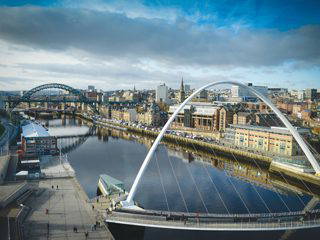
Institute News
John Thirkettle was a Professional Member the Institute of Corrosion from 1982 and later a Fellow of ICorr. He was an active member of the ICorr Midland Branch between 1983 and 1993 and later Aberdeen Branch from 1993. He was Chair of the Scottish Branch of the Pipeline Industries Guild 2000-2021. He was active in the Energy Institute (previously the Institute of Petroleum and was a member of NACE (now AMPP). John sadly passed on 13th August 2022, and his funeral was 1st September in Bedford, where a strong group from the Institute of Corrosion attended to honour his contribution to ICorr, and to the corrosion engineering profession in which he worked since 1962.
John began his career in corrosion engineering with Spencer and Partners in London, where he met Kathy, later his wife. His boss was initially Ken Spencer, the firm’s founder, and then David Lewis, who was to become President of ICorr. He worked with David Harvey at that time. Spencer and Partners were one of a select few companies in corrosion engineering and cathodic protection at the time – they were the only Consulting Engineering firm in the sector.
John left after 7 years, joining another specialist company in the CP industry, Roxby, in 1969, and was eventually Manager of their Cathodic Protection Engineering Division (they were also NDT Engineers) for their entire operations in corrosion and CP in the UK and overseas.
In 1983 John joined Global Cathodic Protection first as Manager for all the CP engineering, installation and commissioning of all onshore and offshore projects. In 1987 he was promoted to Operations Director and in 1989 to Managing Director. To those who worked with him, through his entire career, he was acknowledged as always steady, honest competent and reliable.
John then moved his work to Aberdeen in 1993, firstly as Director of the Corrosion Engineering Division of ACEL and then as Operations Manager of North East Corrosion Engineers. During this time John trained and developed many of the colleagues who are active in CP today.
In 2004 John left the NE and formed Thor Corrosion, becoming, like many senior CP personnel, an Independent Consultant. It is a measure of the man that John continued to assist and work with all many of his past colleagues throughout the following decades. During these many years of friendship, professional contact and project collaboration, John was a leading light and an example to our profession, especially in the training and nurturing of Corrosion Engineers. He wrote the first Institute of Corrosion training programme for Buried Pipeline Cathodic Protection Technicians and Engineers, which he and Chris Lynch presented many years. This has developed into the very successful ICorr CP Training Scheme.
John put a lot into our industry, mostly by voluntary activity, as well as strong activity for ICorr, nationally and in Aberdeen, he was active in the Pipeline Industries Guild and the Energy Institute in Aberdeen. He always ‘put back’ his skills and knowledge to the benefit of others. John was Chair of the committee which produced the 2nd Edition of the Energy Institute’s publication, “Design and Operational Guidance on Cathodic Protection of Offshore Structures, Subsea Installations and Pipelines” published in January 2022.
He was a very competent CP specialist, and one of the first in the UK to recognise the importance of soil potential gradient errors in potential measurements, particularly for buried pipelines (so called IR drop errors).
He was an early user of accurately time interlinked CP power supply switching and data logging to make these Instant OFF surveys more accurate, faster and able to be used as ‘close interval surveys’ to collect data at 1-3m intervals over buried pipelines, these are now ‘normal practice’.
One of his clients sent a note from Dubai on hearing of John’s departure: “I will always remember my time working with John with fondness; he always was willing to share his wisdom, he was patient and always wanted to do what was right” This is typical of many messages received by his family and colleagues about John; unstinting praise for a very well respected and decent colleague.
John was a great collaborator and because of his sincerity and honest character, he gained the trust and confidence of many of his colleagues and clients. To this end his personal touch was key to establishing Corrosion Management Forums at St Fergus, Shetland and Bacton, where the first large scale cross plant CP surveys were performed that not only provided data that were essential and accurate, but largely unique and critically important. These are all running today and they have become a platform for improved collaboration between owner/operators for yet more shared development works and understanding in corrosion. One of the more prominent of these was the investigation and improved understanding of Corrosion Under Insulation (CUI). John progressed this, coordinating and managing the UK CUI Forum. This culminated in a shared state of the art understanding and provided a key contribution to the EFC publication Corrosion-Under-Insulation (CUI).
Let us remember this man who gave so much in example and knowledge to our industry and was liked and respected by all. Our sympathy goes to his wife, Kathy, Emma and James, and their daughter and son.
BS Wyatt and C Lynch
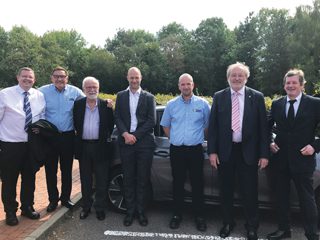
ICorr colleagues of John at the funeral on 1st September 2022. From left to right,
Chris Lynch, Steve Reid, David Harvey, Bill Whittaker, John Rae, Brian Wyatt and Stephen Tate
Institute News, Uncategorized
The branch held its Annual Corrosion Forum (ACF) on 30th August, on the subject of “Energy Transition – Corrosion and Material Challenges.” This was a hybrid presentation at the Palm Court Hotel, Aberdeen. There was a series of in-person and video presentations to a live audience, with a similar number of attendees registered for online viewing of the event, with 71 registered attendees in total.
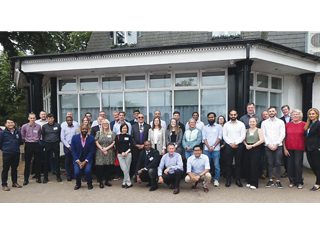
The delegates.
The event programme consisted of a Keynote address by Dr Bill Hedges ICorr President, followed by nine talks on four topic groups, Competency and training, Pipelines, Offshore wind plus solar, nuclear and fusion energy sources, together with practical coating demonstrations run by Presserv Ltd, the key sponsor for the event.
A welcome was given by Hooman Takhtechian – ICorr Aberdeen chair, and Stuart Rennie –Manager (Presserv Ltd).
Bill Hedges then presented on the Institute of Corrosion’s approach to the energy transition landscape, which highlighted a structural materials degradation study conducted by the Henry Royce Institute in collaboration with ICorr and the Frazer-Nash Consultancy. This study looked at the degradation issues affecting structural materials and those critical to delivering the UK’s goal of net-zero greenhouse gas emissions by 2050, a primary objective of which was to identify key R&D opportunities for investment by UK, viz:
• Identify issues which could slow or prevent the transition.
• Ensure the transition occurs in a safe, timely and efficient manner.
• Highlight topics that are common to several industries.
The talk focused on five industries critical for the transition,1. Wind power generation (onshore and offshore). 2. Nuclear fission (not fusion).3. Hydrogen production and usage.4. Transportation (Air, Road, Rail and Sea), and 5. Carbon Capture and storage (CCS).
Of 41 respondents from multiple sectors to the study, 123 inputs (see heat map) gave corrosion as the most dominant topic affecting infrastructure, and slowing the transition to new technologies, closely followed by fatigue.

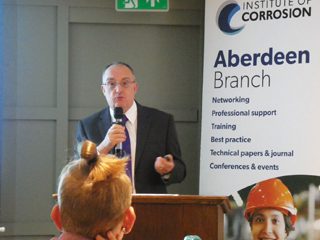
Bill Hedges, ICorr President.
Heat Map of Royce Institute survey responses.
NPL – Carbon capture and storage.
Wood Thilsted – Offshore
wind monopile foundation.
Offshore wind coating challenges (Safinah).
ACF Dinner with Bill Hedges.
ICorr members and engineers are important to the energy transition process, and the majority of members are involved in day-to-day work in Oil &Gas, Hydrogen & Carbon Capture, Wind, Nuclear, and Battery industries.
In the subsequent competency and training session, Muhsen Elhaddad, MSc, CEng, MICorr gave a virtual presentation on the
“Roles of corrosion professionals during energy transition.”
Corrosion is still a major concern to all sectors of the economy. Losses due to corrosion are exorbitant when compared to a country’s GDP (ranges from 1 to 5% in some cases with global average of 3.4%). It is estimated that losses in fresh water supply due to damaged “corroded” infrastructure is higher than 30%. The AWWA (American Water Works Association) estimated that the cost of replacement of corroded pipe will be $325 Billion over the next 20 years. A significant part of these losses is avoidable (15 – 35%) if current knowledge is fully utilised to design, mitigate, monitor and inspect, to control or prevent corrosion.
This of course cannot happen unless there is competent and engaging corrosion and materials professionals involved at all levels of the asset cycle, from conception of the project to decommissioning. People are known to be the heart of effective asset integrity management and can make effective asset integrity happen with their proactive approach, flexibility and a quick response. They must be knowledgeable, have the right competency, and the authority to act on their knowledge, expertise and experience. They should have the means to collaborate, share and communicate at all levels of their organisation and take pride in their profession. This also requires a change in mind set and understanding that a job is not for a salary it is a profession that a corrosion professional needs to embrace and practice fully.
Muhsen’s presentation was very thought provoking and generated many questions from the audience.
For the pipeline session, Frank Cheng, University of Calgary, joined online and spoke informatively on materials constraints and safety assessment in conversion of existing natural gas pipelines for hydrogen transport.
Energy transition and realisation of new energy technologies at full scale are critical to achieving the 2050 net-zero target. Hydrogen, as a green and zero-emission fuel, has received wide attentions recently. Hydrogen delivery is integral to the entire value chain of hydrogen economy, where pipelines provide an economic and efficient means to transport. Particularly, repurposing existing natural gas pipelines is “a low-cost option for delivering large volumes of hydrogen, and similarly for CO2 transport discussed below.
There is an extensive pipeline network throughout the world, effectively transporting energy over several decades. Safety
is paramount for hydrogen transport by pipelines. Particularly, hydrogen embrittlement (HE) has been a major concern for the integrity of hydrogen pipelines. Different from “cathodic” hydrogen generated in aqueous environments where extensive investigations have been conducted, the environment potentially causing HE
of hydrogen pipelines is high-pressure hydrogen gas, in such circumstances hydrogen atom generation and permeation can occur with a mechanism totally different from the “cathodic” hydrogen.
The talk provided technical background about the HE, detailing unique features of the problem associated with high-pressure gaseous environments. Additional challenges with the conversion of existing “aged” gas pipelines for hydrogen service were discussed. These include corrosion and mechanical defects serving as hydrogen traps, pre-strain induced by pipe-soil interaction to increase the
HE susceptibility, competitive adsorption of impurity gases with hydrogen gas on steel surfaces, and preferential accumulation
of hydrogen atoms and the resulting cracking at pipeline welds. Technical gaps are being analysed, and recommendations provided for both the research community and industry to develop a technical assessment programme on the suitability of existing pipelines for hydrogen transport.
In a complimentary way and in person, Shravan Kairy – NPL continued with a discussion on the ‘Challenges in assessing corrosion resistance of pipeline steels in dense phase CO2 .”
Transportation of carbon dioxide (CO2) is essential for the storage of captured anthropogenic CO2 at dedicated locations, such as depleted oilfields. The whole process of capturing, transporting, and storing CO2 is referred to as carbon capture and storage
(CCS). CCS technology has the potential to decarbonise industrial sectors by capturing CO2 prior to its release into the atmosphere. The successful implementation of CCS technology would enable the continued use of available fossil fuels for the world’s energy needs. Pipeline transport of dense phase CO2, i.e., in the liquid
or supercritical phase, enables cost effective high throughput transport. American Petroleum Institute (API) grade pipeline steels that are employed for the pipeline transport of oil and gas are often considered for the transport of dense phase CO2 because of their reliability and low cost.
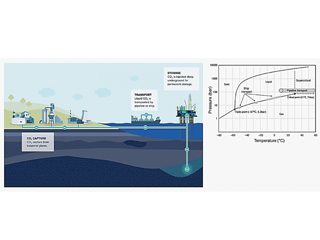
In general, pure CO2 is inert, stable, and non-corrosive. However, anthropogenic CO2 contains various impurities, such as water, sulphur oxides, nitrogen oxides, hydrogen sulphide, and carbon monoxide. If local pipeline conditions (e.g., temperature/pressure) decrease the solubility of water in CO2, condensation can take place and subsequently CO2 and gaseous impurities can dissolve in the condensed water, resulting in an acidic corrosive medium with pH less than 3.5. This leads to corrosion of many pipeline steels and the integrity of the pipeline can be compromised, potentially resulting in leakage or explosion. Understanding the factors controlling corrosion of pipeline steels in the dense phase CO2 environment is essential for qualifying pipeline materials for service and establishing reliable and cost-effective impurity threshold specifications.
NPL’s presentation gave a comprehensive overview of the most common experimental methodologies used to assess corrosion of pipeline steels in dense phase CO2. The current understanding of the corrosion of pipeline steels in dense phase CO2 and recommendations on future directions were also provided.
The Offshore Wind Session commenced with an online presentation by Anthony Setiadi, Wood Thilsted Partners, on the ongoing challenges in corrosion protection of foundations for offshore wind technologies.
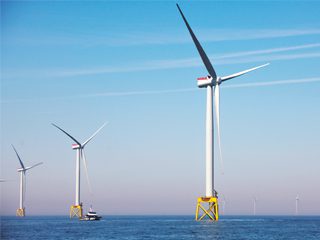
he offshore wind industry growth is rapidly accelerating as the world is pushing towards renewable energy sources. Wind turbines often need to be installed on foundations which are in aggressive environments that are prone to corrosion if not protected and / or designed with corrosion in mind. There are various offshore wind foundation types, such as, monopiles, jackets, tetrabases, gravity bases and floating structures, often grouped in vast arrays for reasons of economy.
The presentation was primarily focused on monopile foundations and the design considerations that would need to be taken onboard. Monopiles have both internal and external surfaces needing protection. Coating requirements and different cathodic protection systems (i.e. galvanic and ICCP) were discussed for the internal
and external of the MP. Challenges regarding positioning of the CP system and installation concerns need to be considered along with any simultaneous operations that need to happen offshore during the installation phases e.g. piling operations that limit placement of anodes on the primary structure.
The main consideration is how the structure would behave with and without corrosion protection, especially the fatigue critical components such as the girth welds. The other consideration would be the site condition which will vary across the wind farm location and in some cases, a clustering strategy for varying sets of marine and geological conditions may be needed.
A corrosion protection plan must be developed and agreed well in advance, which then needs to be followed through to completion, including input to operation and maintenance strategies to ensure that the structure integrity is not compromised throughout design life.
Continuing on the corrosion protection theme, and presenting in person, Simon Daly Consultant – Energy & Infrastructure, (Safinah Group) discussed the many challenges for selecting protective coatings for fixed and floating wind industry.
Offshore wind turbine structures are exposed to environments with high salinity, high levels of UV radiation, the presence of cathodic protection and other factors. As well as the offshore turbines themselves, larger offshore structures such as transformer stations may have more extensive coating requirements including the need for passive fire protection. As the industry transitions to floating structures, designs may also have the challenges associated with marine fouling as well as more extensive coating work scopes.
With longer design lives required for current and future renewable type assets, more dedicated specifications are being developed, however some challenges exist ensuring proper execution of the specification during aggressive construction schedules. Given the costly nature of offshore recertification, this is also an area which requires constant attention to detail to minimise future expenditure.
Corrosion issues within existing fixed wind turbine facilities have highlighted coating requirements more extensive than previously foreseen. Different long term performance requirements, coupled with increased productivity to meet offshore renewables targets, means that coating selection must be carefully considered. Furthermore, with an increased focus on floating wind structures which have additional coating requirements and challenges to consider, the presentation discussed, the types of offshore structures used in wind power generation, different corrosive categories found internally and externally, an overview of corrosion protection issues experienced in fixed bottom structures, existing specifications used in coating selection, and how they differ between fixed and floating wind structures. A comparison of specifications currently used in offshore wind such as NORSOK M-501, DNV, NACE, VGB/BAW as well as development of future specifications, was explained.
This comprehensive presentation concluded with suggestions on how better integration of coating planning and activities throughout the lifecycle of an asset can help to reduce costs associated with coating and related activities.
In the Solar, Nuclear and Fusion Energy Session, Joven Lim – UK Atomic Energy Authority, dealt in great detail with the corrosion challenges in developing a Tokamak-type Fusion Reactor.
With the increase of national interest in developing and deploying clean energy and ensuring a good energy mix for the future, a fusion power plant is one of the ideal candidates. Fusion does not release carbon dioxide or other greenhouse gases into the atmosphere.
Its major by-product is helium gas. Nuclear fusion reactors do not produce high activity, long-lived nuclear waste. The recent record-breaking 59 megajoules of sustained fusion energy demonstrated potential of fusion to be part of the future energy mix at the world-leading Joint European Torus facility, a Tokamak-type fusion reactor design, in Oxford, UK [https://www.euro-fusion.org/news/2022/european-researchers-achieve-fusion-energy-record/].
Like any other thermal power plant, coolant(s) will be used to transfer heat energy generated from fusion reactions and converted to electrical energy. With the knowledge gained from other power plants, and research studies performed in the past, it is feasible to predict and identify the potential corrosion challenges in a Tokamak-type fusion reactor.
In his presentation, the speaker gave a thorough overview of the Tokamak-type fusion reactor design, the potential list of coolants that can be used and why, and the expected corrosion challenges from the extreme environment in the reactor. The speaker also provided some insights on the criteria used for materials selection, corrosion management and mitigation strategy currently being developed for UK STEP fusion programme that aims to deliver a prototype fusion energy plant, by 2040 (https://step.ukaea.uk/).
Bringing the proceedings to a close, after an excellent and well-rounded full day event, Dr Frederick Pessu, University of Leeds, neatly summarised the corrosion challenges and related opportunities in arduous next generation low carbon energy systems (solar and nuclear energy).
Solar and nuclear energy sources have shown the greatest promise overall in worldwide efforts to meet the global climate change target. Electricity generation from solar and nuclear irradiation can be achieved using concentrated solar power (CSP) technologies and Gen IV molten salt nuclear reactors (MSR). Central to both CSP and MSR technologies is the use of high boiling point molten salts (MS) as heat transfer fluid, thermal energy storage and coolants (particularly for MSRs). Thus far, CSPs has played a significant role in delivering large-scale solar thermal electricity generation from photothermal conversion, due to its potential high efficiency, low operation cost and low environmental impact. CSPs promise to contribute up to 27% of global energy by 2050. Gen IV MSRs which are due for commercialisation in 2030 aim to deliver nuclear electricity at about 700°C by 2030, particularly as nuclear electricity is likely to see a 25% contribution to the UK energy mix.
The extreme conditions, high temperature (about 700°C) and aggressive corrosion media in MS systems do however pose complex material degradation issues related to corrosion, chemical speciation kinetics, high temperature fatigue and irradiation induced creep to conventional alloys. The need for advanced material systems/interfaces is timely, especially as the UK’s “green economic revolution” aims to increase nuclear electricity fourfold, achieve net-zero greenhouse gas emissions and fully decarbonise by 2050. The presentation highlighted the corrosion challenges in the new frontier of low carbon and renewable energy generation, solar and nuclear energy, and state – of – the – art understanding of the underpinning mechanisms. Opportunities for research-led development of new material system, interfaces, and technologies for UK businesses were fully discussed.
Presserv Ltd, the sponsor of this Net-Zero event, gave a demonstration of STOPAQ environmentally friendly products and their application on a pipe section, in the reception area.
There are bonus online pre-recorded presentations included as part of the programme which can be viewed online in the ICorr Members site,
• Selection of coating material in oil and gas industries and use of advanced coating processes for corrosion protection in present industrial scenario. Urvesh Vala, Chiyoda Ltd India.
• The use of magnetic probe couple to augment existing equipment and technology. Jonathan Francis, Trac Energy Presentation.
This most successful event, which raised nearly £3,000 for ICorr training funds, was followed by an evening event with the President – Bill Hedges.
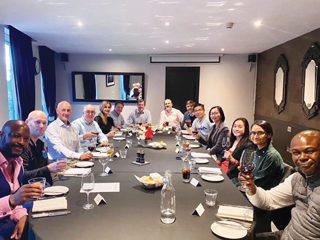
ACF Dinner with Bill Hedges.
The branch gratefully acknowledges the support of all the ACF participants and the ICorr HQ Admin Team.
Event photos and slides can be viewed at: https://1drv.ms/u/s!Ajj3m1kM8SgPrj_TTl_bylOPF1LB?e=EfsRMM.
The Aberdeen Branch has now formed a new committee for 2022-2023 session under the chair of Dr Muhammad Ejaz. Supporting him in the Vice Chair role will be Adesiji Anjorin, the previous events co-ordinator. The full committee are their responsibilities can be found on the branch page of the website.




